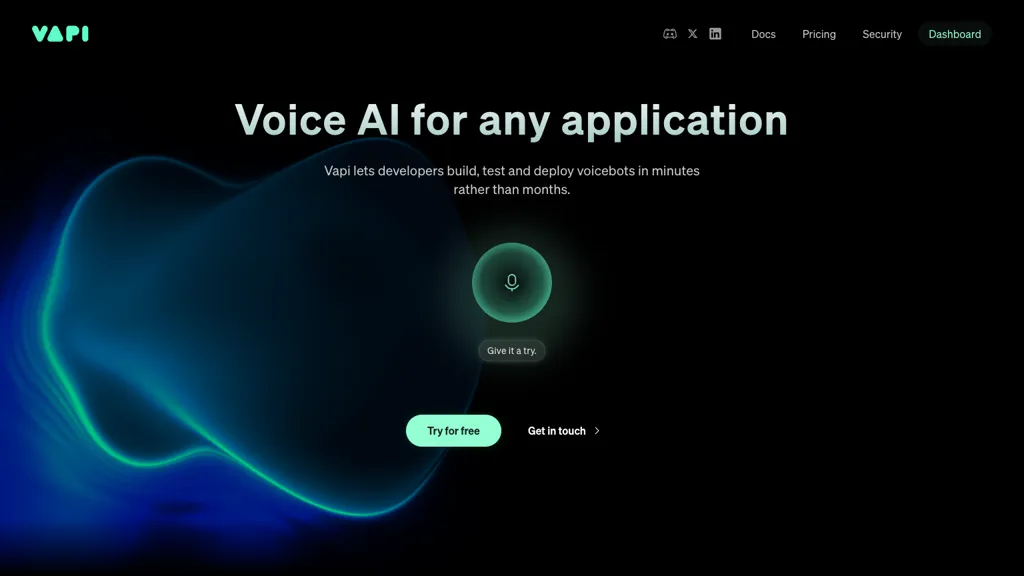What is Vapi?
Vapi, also referred to as Voice AI Application, is the leading tool that gives any developer the capability and ease of creation, testing, and deployment of voicebots at incredible speeds. This application was developed to cater to many uses such as customer support, telehealth, outbound sales, food ordering, logistics transport, and employee training. With Vapi, sophisticated voice solutions are realized within minutes by developers.
Turbo latency optimizations, smart caching, and low-latency audio streaming make Vapi outstanding in delivering fluid and responsive experiences. Besides, its multilingual support, scalable function calling, and customizable models make it an ultra-versatile platform for developing state-of-the-art solutions in voice AI.
Key Features & Benefits – Vapi
- Efficiently build, test, and deploy voicebots.
- Create voice solutions for varied use cases.
- Turbo latency optimizations for seamless performance.
- Support for multiple languages.
- Scalable function calling.
Vapi stands out with the ease of development and deployment of voicebots; in itself, it is much more feasible for a developer or a business looking to integrate voice AI into their operations. Its multilingual support and customizable models further push its applicability across different sectors and user needs.
Use Cases and Applications of Vapi:
The ingenuity of Vapi lies in its variety of applications. The following are examples of how Vapi can be used specifically:
-
Customer Support:
Bring to life voicebots that provide intelligent caching and low-latency audio streaming for real-time assistance and excellent customer experience. -
Telehealth:
Devise voice solutions that can make communication seamless between health providers and patients through multilingualism and custom models that Vapi supports. -
Employee Training:
Interactively build fully customizable training programs using Vapi’s function calling, scalable with its proprietarily developed endpointing models. To this end, industries such as healthcare, customer service, sales, logistics, and so on will find Vapi very instrumental, especially with the advanced capabilities it offers. Its flexibility and ease of use make it a very valuable tool that can be used to enhance operational efficiency and customer engagement.
How to Use Vapi
Getting started with Vapi is quite easy. Here is a step-by-step guide on how to put this powerful tool into action:
-
Sign Up:
Log into Vapi’s website and create an account. -
Choose Your Plan:
You are able to select a pricing plan by your requirements, which you can avail of accordingly. -
Configure Your Voicebot:
With its easy interface, you could design and set up your voicebot. -
Test:
Using Vapi’s testing tools, you’ll be able to make sure that the voicebot actually works the way it’s supposed to. -
Deploy:
When the performance is to your satisfaction, deploy your voicebot into live action.
Best Practices:
For best practices, leverage Vapi’s turbo latency optimizations and intelligent caching for improved performance. Refresh your models from time to time to maintain continuous efficiency and accuracy of your voicebot.
How Vapi Works
Vapi’s underlying sophisticated technology consists of complex algorithms and models. Optimizations done in Turbo for latency reduction ensure great responsiveness in all voice interactions. Intelligent caching enables top performance for frequently accessed data.
The normal workflow usually encompasses the construction of the voicebot on Vapi’s easy-to-use interface, testing it for any brokenness, and finally deploying it for production. All along this process, scalable function calling and models customization by Vapi will be critical in personalizing the VoiceBot to specific use cases and requirements.
Vapi Pros and Cons
Though Vapi has many benefits, there are a few areas where improvement is needed. These include the following:
Pros
- Fast and effective voicebot development.
- Multilingualism support.
- Turbo latency optimizations.
- Customizable models to tailor solutions.
- A free trial is available.
The cost can be high for the more advanced plans. There is probably a learning curve for new users. Nearly every user review indicates how easy it is to use Vapi and the power of its features. Some have mentioned the higher price of advanced plans as a limitation.
Conclusion on Vapi
In a nutshell, Vapi is an incredibly strong AI application for voices, making the creation, testing, and deployment of voice bots easier. It has key features, such as turbo latency optimizations, multilingual support, and scalable function calling, that turn it into an all-industry-usable tool. Of course, the pricing for advanced plans may be a bit high, but it’s still worth it with the value brought along by its robust capabilities together with a friendly user interface.
Looking forward to the future, Vapi will perhaps go on and evolve with new features and improvements, but for now, it has made a good case for itself as one of the most exciting tools for any developer or business. Vapi will be of great value to any business looking to integrate voice AI into its operations.
Vapi FAQs
-
What is Vapi?
Vapi is an application that allows voice AI-based developers to quickly build, test, and deploy voicebots effectively and easily. -
Who can use Vapi?
It can also be useful to different user groups, such as developers, product managers, AI engineers, business owners, call center managers, sales teams, and healthcare professionals. -
Does Vapi have a free trial?
Yes, Vapi provides a free trial that offers trial use of the platform before upgrading to a paid package. -
What are the pricing plans available with Vapi?
The pricing plans that Vapi has in store for us include a $36 plan for Transcription + chatgpt-3.5-turbo + provider key voice plan, and a $3200 plan for Transcription + custom llm + playht voice plan. Kindly confirm the latest pricing from Vapi’s official website. -
What are some of the major features of Vapi?
Major features of Vapi include efficient voicebot development, turbo latency optimizations, multilingual support, scalable function calling, and customizable models.










